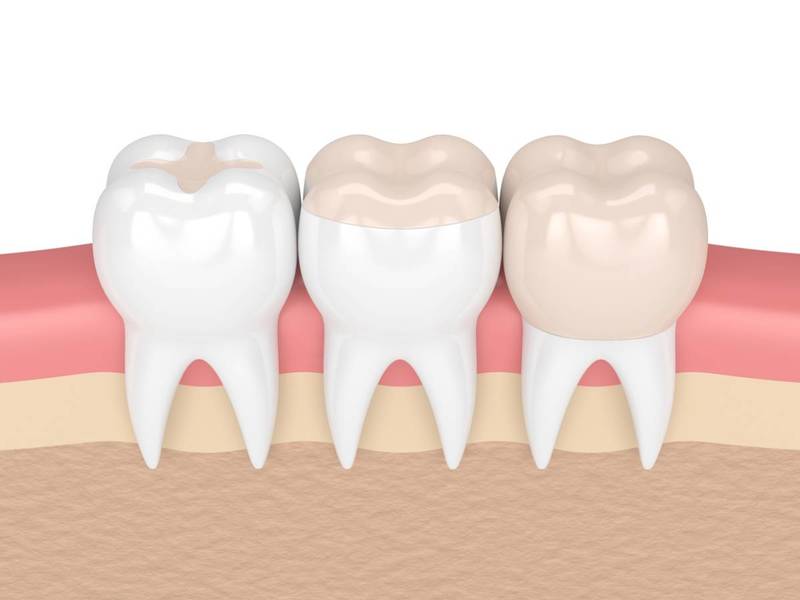
Dental bonding and fillings are distinct dental procedures with unique purposes. Dental bonding is a cosmetic solution that enhances the appearance of teeth by applying a tooth-colored resin to correct imperfections like chips, gaps, discoloration, or tooth shape. A special light hardens the resin, improving the tooth’s aesthetics. Conversely, dental fillings are primarily employed to treat cavities resulting from tooth decay. This involves removing the decayed portion and filling the void with materials like amalgam or composite resin. Fillings restore the tooth’s structure and function, preventing further decay.
In summary, dental bonding and fillings serve divergent roles: bonding for cosmetic enhancements and fillings for addressing decay-related issues. Understanding these distinctions is crucial for selecting the appropriate treatment based on your specific dental needs, ensuring both dental health and aesthetics.

Is Dental Bonding the Same as a Filling?
Dental bonding and fillings are both common dental procedures that aim to restore the health and appearance of teeth. However, they are not the same thing. While they serve similar purposes, there are distinct differences between dental bonding and fillings. In this article, we will explore the characteristics, benefits, and applications of both procedures to help you understand the key distinctions.
What is Dental Bonding?
Dental bonding is a cosmetic procedure using tooth-colored resin to fix issues like chipped, cracked, or discolored teeth. It matches your natural tooth color for a seamless look and can often be done in one dental visit. The process involves preparing the tooth surface, applying the resin, shaping it, and then hardening it with a special light for a proper fit and bite.
Benefits of Dental Bonding
1. Cosmetic Enhancement: Dental bonding can significantly improve the appearance of teeth by addressing imperfections such as discoloration, chips, or gaps.
2. Minimally Invasive: Unlike other cosmetic dental procedures, bonding typically requires minimal alteration of the natural tooth structure, preserving the overall integrity of the tooth.
3. Quick and Convenient: Dental bonding can often be completed in a single dental visit, making it a convenient option for patients seeking immediate results.
4. Cost-Effective: Compared to other cosmetic dental treatments, dental bonding is generally more affordable, making it an accessible option for many patients.
5. Versatility: Dental bonding can be used to address a wide range of cosmetic concerns, providing a versatile solution for patients with various dental needs.
What are Dental Fillings?
Dental fillings, on the other hand, are restorative procedures primarily used to treat cavities and decayed teeth. When a tooth is affected by decay, the damaged portion of the tooth is removed, and a filling material is used to fill the resulting void. The filling material helps restore the tooth’s functionality and prevents further decay or damage.
Traditionally, dental fillings were made of materials such as amalgam (a mixture of metals) or gold. However, with advancements in dental materials, composite resin fillings that match the color of natural teeth have become more popular. These tooth-colored fillings offer a more aesthetically pleasing alternative to traditional metal fillings.
Types of Dental Fillings
1. Amalgam Fillings: Amalgam fillings are composed of a mixture of metals, including silver, mercury, tin, and copper. They are known for their durability and strength, making them suitable for filling large cavities in the back teeth.
2. Composite Fillings: Composite fillings are made of a tooth-colored resin material. They are popular for their natural appearance and versatility. Composite fillings can be used to restore both front and back teeth and are especially useful for smaller cavities.
3. Ceramic Fillings: Ceramic fillings, also known as porcelain fillings, are made of a strong and durable ceramic material. They are highly resistant to staining and can be color-matched to blend seamlessly with the natural teeth.
Differences Between Dental Bonding and Fillings
While dental bonding and fillings share the goal of restoring teeth, there are several key differences between the two procedures:
1. Purpose: Dental bonding is primarily a cosmetic procedure designed to enhance the appearance of teeth, while fillings are restorative procedures aimed at treating cavities and decay.
2. Material: Dental bonding uses a tooth-colored resin material, whereas fillings can be made of amalgam, composite resin, or ceramic.
3. Preparation: Dental bonding typically requires minimal tooth preparation, while fillings often involve the removal of decayed tooth structure.
4. Application: Dental bonding involves the application of a resin material directly to the tooth surface, while fillings are placed inside the prepared cavity.
5. Durability: Dental bonding is generally less durable than fillings and may require periodic maintenance or replacement.
In conclusion, dental bonding and fillings are two distinct dental procedures with different purposes and applications. Dental bonding is primarily a cosmetic treatment that can address various aesthetic concerns, while fillings are restorative procedures used to treat cavities and decay. Understanding the differences between these procedures can help you make informed decisions about your dental health and choose the most appropriate treatment option for your specific needs.
Key Takeaways: Is Dental Bonding the Same as a Filling?
- Dental bonding and fillings are similar in that they both restore teeth, but they have different purposes.
- Dental bonding is used to repair minor cosmetic issues, such as chipped or discolored teeth.
- A filling, on the other hand, is used to restore a tooth that has decay or a cavity.
- Dental bonding involves applying a tooth-colored resin to the affected area and shaping it to match the natural tooth.
- A filling involves removing the decayed portion of the tooth and filling it with a material like amalgam or composite resin.
Frequently Asked Questions
Question 1: What is dental bonding?
Dental bonding is a cosmetic dental procedure that involves the application of a tooth-colored resin material to the surface of a tooth. It is commonly used to improve the appearance of chipped, cracked, or discolored teeth. The resin is carefully sculpted and bonded to the tooth, creating a natural-looking restoration.
Unlike a filling, which is used to repair a cavity or decayed tooth, dental bonding is primarily a cosmetic treatment. It is a non-invasive procedure that can usually be completed in a single visit to the dentist.
Question 2: How does dental bonding differ from a filling?
Dental bonding and fillings serve different purposes and are used for different dental issues. While both procedures involve the application of a material to the tooth, the materials used and the purpose of the treatment differ.
A filling is used to repair a tooth that has been damaged by decay or cavities. It involves removing the decayed portion of the tooth and filling the space with a durable material such as amalgam or composite resin. Dental bonding, on the other hand, is primarily a cosmetic procedure aimed at improving the appearance of the tooth.
Question 3: What are the advantages of dental bonding?
Dental bonding offers several advantages as a cosmetic dental treatment. Firstly, it is a relatively quick and non-invasive procedure that can usually be completed in a single visit. Secondly, it is an affordable option compared to other cosmetic treatments such as veneers or crowns. Additionally, dental bonding can be used to address a variety of aesthetic concerns, including chipped teeth, gaps between teeth, and tooth discoloration.
Furthermore, dental bonding is a versatile treatment that can be used on both front and back teeth. It is a conservative approach that preserves more of the natural tooth structure compared to other restorative procedures.
Question 4: How long does dental bonding last?
The lifespan of dental bonding can vary depending on several factors, including the oral hygiene habits of the individual and the location of the bonding material. On average, dental bonding can last between 5 to 10 years. However, with proper care and regular dental check-ups, it is possible for dental bonding to last even longer.
It is important to note that dental bonding can be more prone to staining and chipping compared to other restorative materials such as porcelain. Avoiding habits such as biting on hard objects and maintaining good oral hygiene can help prolong the lifespan of dental bonding.
Question 5: Can dental bonding be used to replace a filling?
In some cases, dental bonding can be used to replace a filling. If a small or shallow filling needs to be replaced, dental bonding can be a suitable alternative. However, if the filling is large or the tooth requires more extensive restoration, other options such as dental crowns or inlays/onlays may be recommended by the dentist.
It is best to consult with a dentist to determine the most appropriate treatment option for replacing a filling and to discuss the advantages and limitations of dental bonding in your specific case.
Dental Bonding vs Porcelain Veneers – Which Should I Get?
Final Thoughts
Dental bonding and fillings, though sharing similarities, serve distinct purposes. Dental bonding uses composite resin to enhance appearance and fix minor damage, while fillings repair cavities and restore tooth structure. To choose between them, consulting your dentist is vital, as they’ll assess your unique dental needs and recommend the suitable treatment. Every case differs, and trusting your dentist’s expertise ensures proper care. In essence, bonding and fillings are not interchangeable; understanding the differences and seeking professional advice is crucial. Whether improving smile aesthetics or addressing decay, your dentist’s guidance guarantees optimal care. Schedule an appointment to embark on a journey towards a healthier, more beautiful smile.
Call or Book appointment online
:Ace Dental Care Alpharetta office: 678-562-1555 - Book Now
Ace Dental Care Norcross office: 770-806-1255 - Book Now
Disclaimer
This blog post was generated by artificial intelligence. The content of this post may not be accurate or complete, and should not be relied upon as a substitute for professional advice. If you have any questions about the content of this post, please contact us.
We are constantly working to improve the accuracy and quality of our AI-generated content. However, there may still be errors or inaccuracies. We apologize for any inconvenience this may cause.





